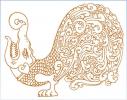Karava of Sri Lanka
Castes
- What are Castes ?
Castes (kula, Jathi in Sinhalese) were an anciant social categorisation based on traditional occupations. It enabled the smooth functioning of fudal societies.
In India and Sri Lanka the framework of the Caste system is four fold. In India due to its Hindu origin and sustenance, the Brahmin caste is the highest caste. However as the Buddha was from the Kshatriya royal caste, all ancient Buddhist leterature places the Royal caste on top. In Sri Lanka, within the 4 main caste classifications there are many sub castes. The 4 main caste groups in Sri Lanka are:
1. Kshatriya - Royals, nobles, warriors, land owners
2. Brahmina - priests
3. Vaisya - Traders, land owners
4. Sudra - food producers and workersAll the ancient Sinhala literature of Sri Lanka, state the above in Sinhalese as follows:
1. Raja - Royals, nobles & warriors
2. Bamunu - Brahmins
3. Velenda - Traders
4. Govi - food producers and workers- Do they exists now ?
Yes although no one is now bound by their traditional occupations, castes do still exist. For example the largest Buddhist sect the Siyam Nikaya is a strictly Govigama sect and it does not allow Buddhists of any other caste to enter it. A glimpse at the marriage proposal advertisements in local newspapers will show that most of them mention the caste of the candidates and requests replies only from those of the same caste.
- Are they relevant today ?
They are not relevant as far as choice of occupations go. However they appear to be relevant in politics and in the largest order of Buddhist monks the Siyam Nikaya. They also appear to be relevant if you go by the marriage proposal advertisements in local newspapers. Possibly the parents are worried that the offspring from a mixed caste marriage may find it difficult to find partners in the future, as it was in the past and sometimes even today. There also appears to be endemic prejudice and discriminations against some castes and as such almost daily there are notices in newspapers of entire families changing their ancestral names into main stream impressive names.
- What is the higest caste ?
All ancient Sinhala literature and rock inscriptions of Sri Lanka, state the Sri Lankan caste classification as follows:
1. Raja - Royals, nobles & warriors
2. Bamunu - Brahmins
3. Velanda - Traders
4. Govi - food producers and workersAs such the Royal warrior caste was the highest and the Govi caste was the lowest in the historical Sri Lankan caste structure.
That had been the local adaptation of the following Indian terms and labels:
1. Kshatriya - Royals, nobles, warriors, land owners
2. Brahmina - priests
3. Vaisya - Traders, land owners
4. Sudra - food producers and workers- Will castes dissapear soon ?
Yes many of the minority castes have already disappeared. A study of family name change notices published in newspapers indicate that most castes are merging with the Govigama caste. Inter-caste marriages are not uncommon now but you can still see the castes of both parents mentioned in marriage proposal advertisements, probably because it is still relevant for society.
Kshatriya Maha Sabha, Sri Lanka
